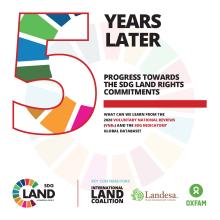/ library resources
Showing items 1 through 9 of 5066.Landscape connectivity is increasingly promoted as a conservation tool to combat the negative effects of habitat loss, fragmentation, and climate change. Given its importance as a key conservation strategy, connectivity science is a rapidly growing discipline.
The optimization of ecological resource allocation is increasingly seen as a potential solution for urban revitalization and sustainable land use planning, and the key point is to assess and simulate the spatial arrangement of the ecological land.
In 2015 we celebrated world leaders’ recognition of the foundational and strategic role that secure land rights for all –women and men, regardless of ethnicity, religion, place of residence, or civil, economic, social, or political status—must play to achieve a world free of poverty, hunger and s
This report provides a summary of a two-part online workshop in June 2020 to explore the creation of a community of experts to support the ongoing development of the LandVoc concept scheme, and to support ongoing contributions from the LandVoc community to AGROVOC.
In 2015, 193 countries affirmed their commitment to the 17 goals of the 2030 Agenda for Sustainable Development, including Germany. According to an estimate by the United Nations in 2018, the international community loses 5% of global gross domestic product through corruption.
Over the past two decades, academics and development practitioners have written extensively about the harmful impact of corruption on economic development and social outcomes.
La terre a toujours été un bien très contesté. Le contrôle des terres et des ressources liées reflète les relations de pouvoir d’une région, d’un pays et constitue un indicateur des injustices sociales existantes.
Three-quarters of emerging infectious diseases are zoonoses, meaning they can be transmitted from animals to humans, with Ebola, SARS, MERS and now COVID-19 being examples.
Indigenous Peoples and local communities manage more than half of the world´s land. These biodiverse ancestral lands are vital to the people who steward them and the planet we all share. But governments only recognize indigenous and community legal ownership of 10 percent of the world´s lands.
Pagination
Land Library Search
Through our robust search engine, you can search for any item of the over 73,000 highly curated resources in the Land Library.
If you would like to find an overview of what is possible, feel free to peruse the Search Guide.






